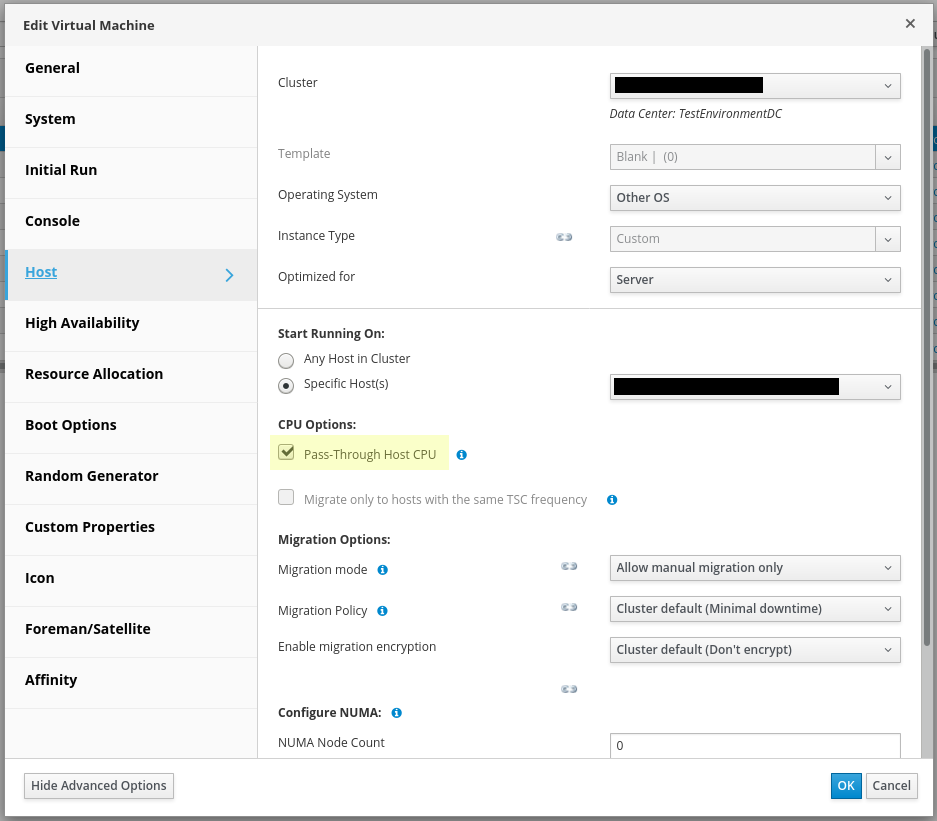- RHEL 7 virtual machine with nested virtualization and some packages installed.
- OCM API Token from here.
$ git clone https://github.com/kevydotvinu/disconnectedocponkvm
$ cd disconnectedocponkvm
$ sed -i 's/RELEASE=.*/RELEASE=4.7.7/' env
$ sed -i 's/OCM_TOKEN=.*/OCM_TOKEN=<your-token>/' env
$ cd cluster-files
$ bash deploy.sh
Note: If anything breaks in the middle, fix the issue and re-run the
bash deploy.shcommand.
Note: Trimmed the terminal session from where it waits long.
-
Creating a cluster with the below customization will be hassle-free
- Disconnected cluster.
- Connected cluster with proxy.
- Provision nodes using PXE server.
- Add RHEL nodes.
-
The deployment completes considerably fast since we have created all the piece parts as ready-to-run scripts.
- Nodes use KVM ready images and cli provisioning.
- Downloading and setting up the requiremnets are just a matter of running a script.
- Using PXE server and proxy will not be easy.
- Accessing boot menu or serial console are annoying.
- Save time from infra preparation.
- All work can be done without leaving the terminal.
- Created the script steps with fuction in it so it is easy to remove the piece parts just by commenting it.
- It is Vagrant kind of directory structure. All the related files and configurations are placed inside its own direcotry.
- Serial console can be accessible from terminal - Good for network related scenarios.
- Boot menu can be accessible from terminal - No need to relay on GUI console which usually opens just after the max time to hit the TAB or 'e'.
- A virtual machine with the below resources:
| CPU | RAM | Storage |
|---|---|---|
| 30 | 120 GB | 300 GB |
Note: A disk should be added with the
Allocation Policy: Preallocated. If it is an additional disk other than the OS disk to host the complete installation files, make filesystem usingmkfs -t xfs -n ftype=1 /dev/<disk>command because for overlay fs,ftype=1is a requirement.
- RHEL 7 operating system
Note: Create additional disk of 300 GB if RHEL 7 installation uses a template.
- Nested virtualization - The below is the pass-through host CPU configuration in RHV environment
$ git clone https://github.com/kevydotvinu/disconnectOCPonKVM && \
cd disconnectOCPonKVM
Note: In the remainder of the steps, we will assume that we are in the above directory and switch to other if requried.
$ subscription-manager register
$ subscription-manager repos --enable="rhel-7-server-rpms" \
--enable="rhel-7-server-extras-rpms" \
--enable="rhel-7-server-ansible-2.9-rpms" \
--enable="rhel-7-server-ose-4.7-rpms"
$ yum -y update
$ yum groupinstall -y virtualization-client virtualization-platform virtualization-tools
$ yum install -y screen podman httpd-tools jq git openshift-ansible
$ bash configureHost.sh -s all
$ sed -i 's/RELEASE=.*/RELEASE=4.7.7/' env
$ cd downloads && \
bash downloadFiles.sh && \
bash sshAndPullsecret.sh '<ACCESS_TOKEN>'
$ cd ../registry && \
bash createRegistry.sh && \
bash startRegistry.sh
$ cd ../cluster-files && \
bash install-config.sh -t disconnected -i non-proxy && \
bash createManifestsAndIgnitionConfig.sh
$ cd ../proxy && \
bash creatSquid.sh && \
bash startSquid.sh
$ cd ../cluster-files && \
bash install-config.sh -t connected -i proxy && \
bash createManifestsAndIgnitionConfig.sh
$ cd ../cluster-files && \
bash install-config.sh -t connected -i non-proxy && \
bash createManifestsAndIgnitionConfig.sh
$ cd ../cluster-files && \
bash install-config.sh -t singlenode -i proxy && \
bash createManifestsAndIgnitionConfig.sh
$ bash sncPatch.sh
$ cd ../cluster-files && \
bash install-config.sh -t singlenode -i non-proxy && \
bash createManifestsAndIgnitionConfig.sh
$ bash sncPatch.sh
$ cd ../bootstrap && \
bash bootstrap.sh
$ cd ../master/master0 && \
bash master0.sh
$ cd ../master/master1 && \
bash master1.sh
$ cd ../master/master2 && \
bash master2.sh
$ cd ../worker/worker0 && \
bash worker0.sh
$ cd ../worker/worker1 && \
bash worker1.sh
$ cd ../../pxe && \
bash createPXE.sh && \
bash startPXE.sh
$ cd ../worker/worker2 && \
bash worker2.sh
$ cd ../rhel8 && \
bash create rhel8
$ bash hosts.sh && \
ansible-playbook -i hosts /usr/share/ansible/openshift-ansible/playbooks/scaleup.yml
$ bash approve.sh
$ sed -i 's/RELEASE=.*/RELEASE=4.7.7/' env
$ cd registry && \
bash mirror.sh
$ source ./env
$ cd registry
$ oc create -f checksum-${RELEASE}.yaml
$ TOIMAGE=$(oc adm release info ${PULLSECRET} mirror.${CLUSTER_NAME}.${DOMAIN}:5000/ocp4/openshift4:${RELEASE}-x86_64 | grep "Pull From" | cut -d" " -f3)
$ oc adm upgrade --to-image=${TOIMAGE} --allow-explicit-upgrade
$ bash configureHost.sh -s vms-internet
$ cd downloads
$ skopeo copy --authfile pull-secret.json docker://quay.io/openshift/origin-must-gather \
docker-archive:$(pwd)/must-gather.tar
$ ssh core@bootstrap
$ cd /tmp
$ scp <user>@<IP>:/path/must-gather.tar .
$ skopeo copy docker-archive:$(pwd)/must-gather.tar containers-storage:quay.io/openshift/origin-must-gather
$ podman images | grep must-gather
$ cd downloads
$ skopeo copy --authfile pull-secret.json docker://registry.redhat.io/rhel8/support-tools \
docker://mirror.${CLUSTER_NAME}.${DOMAIN}:5000/rhel8/support-tools
$ cat << EOF > image-policy-2.yaml
apiVersion: operator.openshift.io/v1alpha1
kind: ImageContentSourcePolicy
metadata:
name: image-policy-2
spec:
repositoryDigestMirrors:
- mirrors:
- mirror.${CLUSTER_NAME}.${DOMAIN}:5000/rhel8/support-tools
source: registry.redhat.io/rhel8/support-tools
EOF
$ oc create -f image-policy-2.yaml
$ watch oc get mcp
If we are working with nework related problem, TTY conosle login is possible with this using VM's serial console.
$ cd cluster-files
$ perl -e 'print crypt("bar","\$6\$SALT\$") . "\n"'
$ cat << EOF > passwd.bu
variant: fcos
version: 1.3.0
passwd:
users:
- name: foo
password_hash: $6$SALT$HsCT89cn4dek.8MuFh5ZRlC5A5ofnlqB6FxLX7v/lssLC7/6rutMtCvZxsixpkpLn9GXr1iiLuQyB8DpI2lyz/
storage:
files:
- path: /etc/ssh/sshd_config.d/20-enable-passwords.conf
mode: 0644
contents:
inline: |
PasswordAuthentication yes
EOF
$ podman run --interactive --rm quay.io/coreos/butane:release --pretty --strict < passwd.bu > passwd.ign
$ [ -f bootstrap.ign.bkp ] || cp bootstrap.ign bootstrap.ign.bkp
$ jq -c --argjson var "$(jq .passwd.users passwd.ign)" '.passwd.users += $var' bootstrap.ign.bkp > bootstrap.ign.1
$ jq -c --argjson var "$(jq .storage.files passwd.ign)" '.storage.files += $var' bootstrap.ign.1 > bootstrap.ign
$ rm -vf bootstrap.ign.1
Add the below entries in the machine where the cluster does access.
<kvm-host-ip> api.${CLUSTER_NAME}.${DOMAIN}
<kvm-host-ip> oauth-openshift.apps.${CLUSTER_NAME}.${DOMAIN}
<kvm-host-ip> console-openshift-console.apps.${CLUSTER_NAME}.${DOMAIN}
cd registry &&
bash checkUpgradePath.sh

